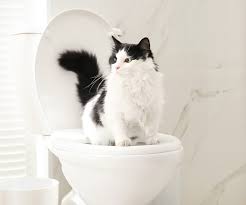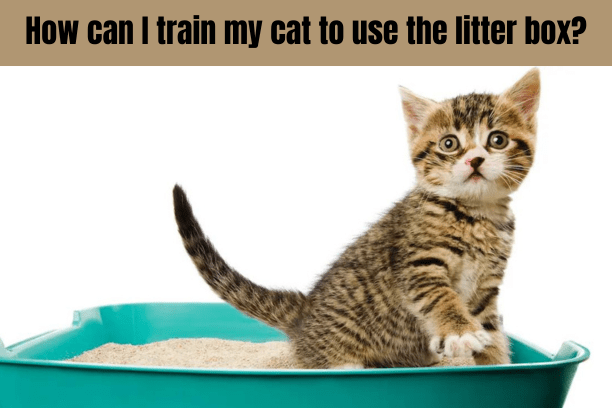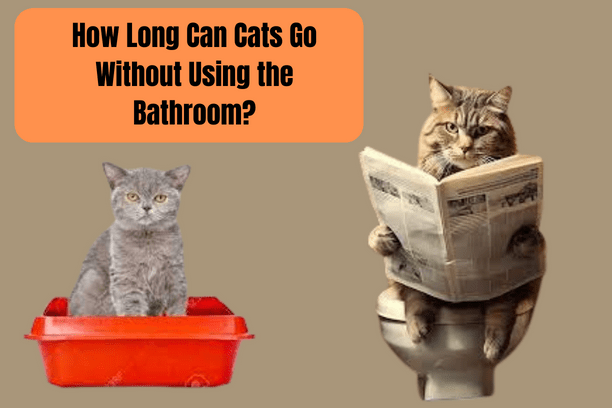how long can cats go without using the bathroom? This is an important question, especially if you travel with your cat or notice any changes in their litter box habits. Knowing how often your cat should pee and poop can help you monitor their health and prevent potential problems.
In this article, we will explore the factors that affect your cat’s urinary and bowel movements, the signs of trouble, and the tips to keep your cat comfortable and regular.
Contents
- 1 How Long Can Cats Go Without Using the Bathroom?
- 2 How Long Can Cats Go Without Pooping?
- 3 What Factors Can Affect a Cat’s Bathroom Frequency?
- 4 What Are the Signs of a Cat Having Trouble With the Bathroom?
- 5 When Is It Time to Visit the Vet with Your Cat?
- 6 How Can You Help Your Cat Use the Bathroom Comfortably?
- 7 How can I train my cat to use the litter box?
- 8 How long can a kitten go without using the bathroom?
- 9 Do cats hold their pee when stressed
- 10 Conclusion
How Long Can Cats Go Without Using the Bathroom?
Peeing is a natural and essential function for cats, as it helps them eliminate waste and toxins from their body. Most cats, depending on their age, food, and water consumption, will urinate two to three times a day. However, some cats may pee more or less frequently than that, depending on various factors.
According to, it is normal for cats to go without using the bathroom and hold their poop and pee for up to 48 hours. However, this can vary depending on their age, diet, and overall health. It is essential to keep an eye on your cat’s bathroom habits, and if you notice any changes or concerns, seek veterinary attention immediately.
If your cat has not peed for more than 48 hours, it could be a sign of a serious problem, such as a urinary tract infection, bladder stones, kidney disease, or a urinary blockage. These conditions can be very painful and potentially life-threatening for your cat, so you should not delay taking your cat to the vet.
How Long Can Cats Go Without Pooping?
Pooping is another vital function for cats, as it helps them get rid of undigested food and other substances from their digestive system. Most cats will poop about once a day, depending on their age, diet, and activity level. However, some cats may poop more or less often than that, depending on various factors.
According to, a cat can go for 24-48 hours without pooping, with the average feline holding it for about 36 hours. While it isn’t ideal for your cat to do this, it isn’t necessarily harmful. However, going past 48 hours should be a concern, and you should consult your vet.
If your cat has not pooped for more than 48 hours, it could be a sign of a problem, such as constipation, dehydration, hairballs, intestinal obstruction, or megacolon. These conditions can cause discomfort, bloating, loss of appetite, vomiting, and weight loss for your cat, so you should not ignore them.
Suggested: What If My Cat Licks Silver Sulfadiazine?
Cat Not Eating After Dental Surgery
What Factors Can Affect a Cat’s Bathroom Frequency?
As mentioned earlier, many factors can influence how often your cat uses the bathroom, such as:
- Age: Kittens and senior cats tend to have more frequent bathroom habits than adult cats, as they have less control over their bladder and bowel movements. Kittens may pee and poop several times a day, while senior cats may have reduced kidney function and lower water intake, which can affect their urine output and stool consistency.
- Diet: The type and quality of food your cat eats can have a significant impact on their bathroom frequency. Wet food, which has a higher moisture content, can help your cat stay hydrated and pee more often. Dry food, which has a lower moisture content, can cause your cat to drink less and pee less often. The amount and frequency of food your cat eats can also affect their pooping schedule. Feeding your cat too much or too little, or changing their diet abruptly, can cause diarrhea or constipation.
- Water intake: The amount of water your cat drinks can also affect their bathroom frequency. Water is essential for your cat’s health, as it helps flush out toxins and waste from their body. If your cat drinks enough water, they will pee more often and have softer stools. If your cat drinks too little water, they will pee less often and have harder stools. You should always provide your cat with fresh and clean water, and encourage them to drink more by using a fountain, adding water to their food, or offering them wet food.
- Activity level: The amount of exercise your cat gets can also affect their bathroom frequency. Exercise can help your cat stimulate their blood circulation and digestion, which can help them pee and poop more regularly. Lack of exercise can cause your cat to become sluggish and constipated, which can reduce their bathroom frequency. You should provide your cat with enough physical and mental stimulation, such as toys, scratching posts, and interactive games, to keep them active and healthy.
- Stress: The level of stress your cat experiences can also affect their bathroom frequency. Stress can cause your cat to have behavioral or medical issues, such as inappropriate elimination, urinary tract infection, bladder inflammation, or interstitial cystitis. These issues can cause your cat to pee or poop more or less often, or in places other than the litter box. You should try to identify and eliminate the sources of stress for your cat, such as changes in the environment, new pets or people, loud noises, or lack of attention.
What Are the Signs of a Cat Having Trouble With the Bathroom?
As a cat owner, you should be aware of the signs that your cat is having trouble with the bathroom, such as:
- Changes in bathroom frequency: If your cat is peeing or pooping more or less often than usual, it could indicate a problem. For example, peeing more often could mean a urinary tract infection, while peeing less often could mean a urinary blockage. Pooping more often could mean diarrhea while pooping less often could mean constipation.
- Changes in bathroom location: If your cat is peeing or pooping outside the litter box, it could indicate a problem. For example, peeing outside the litter box could mean a behavioral issue, such as stress, anxiety, or marking territory, or a medical issue, such as a urinary tract infection, bladder inflammation, or interstitial cystitis. Pooping outside the litter box could mean a behavioral issue, such as stress, anxiety, or litter box aversion, or a medical issue, such as constipation, hairballs, intestinal obstruction, or megacolon.
- Changes in bathroom appearance: If your cat’s pee or poop looks different than usual, it could indicate a problem. For example, pee that is dark, cloudy, bloody, or has a strong odor could mean a urinary tract infection, bladder stones, kidney disease, or a urinary blockage. A poop that is hard, dry, small, or has blood, mucus, or worms could mean constipation, dehydration, hairballs, intestinal obstruction, or parasites.

When Is It Time to Visit the Vet with Your Cat?
If you notice any of the signs mentioned above, or if you are concerned about your cat’s bathroom habits, you should take your cat to the vet as soon as possible. Some of the problems that can affect your cat’s bathroom frequency can be very serious and potentially life-threatening, so you should not delay seeking professional help.
Your vet will examine your cat and perform some tests, such as urine analysis, blood work, x-rays, or ultrasound, to diagnose the problem and prescribe the appropriate treatment. Depending on the problem, your cat may need medication, surgery, fluid therapy, dietary changes, or behavioral modification.
How Can You Help Your Cat Use the Bathroom Comfortably?
As a cat owner, you can help your cat use the bathroom comfortably by following some simple tips, such as:
- Provide a clean and accessible litter box: You should provide your cat with a litter box that is large enough, comfortable, and easy to access. You should also keep the litter box clean scoop it daily, and change the litter completely every week. You should avoid using scented or dusty litter, as it can irritate your cat’s nose and lungs. You should also have one more litter box than the number of cats in your home, and place them in different locations, away from food, water, and noise.
- Encourage your cat to drink more water: You should encourage your cat to drink more water, as it can help prevent dehydration, urinary tract infections, bladder stones, kidney disease, and constipation. You should provide your cat with fresh and clean water, and change it daily. You should also use a fountain, add water to their food, or offer them wet food, to entice them to drink more.
- Feed your cat a balanced and high-quality diet: You should feed your cat a balanced and high-quality diet, as it can help maintain their health and prevent urinary tract infections, bladder stones, kidney disease, and constipation. You should choose a diet that is appropriate for your cat’s age, size, and activity level, and consult your vet for recommendations. You should also avoid feeding your cat too much or too little, or changing their diet abruptly, as it can cause diarrhea or constipation.
- Provide your cat with enough exercise and stimulation: You should provide your cat with enough exercise and stimulation, as it can help stimulate their blood circulation and digestion, and prevent urinary tract infection, bladder inflammation, interstitial cystitis, and constipation. You should provide your cat with toys, scratching posts, and interactive games, to keep them active and entertained. You should also spend some quality time with your cat, and give them attention and affection, to reduce their stress and anxiety.
How can I train my cat to use the litter box?
Training your cat to use the litter box is usually easy, as most cats have an instinct to bury their waste. However, some cats may need some guidance and encouragement, especially if they are kittens, strays, or have developed bad habits. Here are some steps you can follow to train your cat to use the litter box:
- Choose a large, clean, and accessible litter box that suits your cat’s preferences. Some cats may like covered or uncovered boxes, different types of litter, or different locations. You may need to experiment with different options until you find what your cat likes.
- Place the litter box in a quiet, low-traffic area, away from your cat’s food and water. Make sure your cat can easily access the litter box, and that there are no obstacles or barriers that might prevent them from using it. If you have more than one cat, provide each cat with a litter box, plus one extra.
- Your cat can investigate the litter box if you show it to them. You can gently place your cat in the litter box and scratch the litter with your finger to demonstrate how to use it. Praise and reward your cat with treats or toys if they show interest or use the litter box. Do not force your cat to stay in the litter box or punish them for not using it, as this can create a negative association.
- Monitor your cat’s bathroom habits and look for signs that they need to go, such as sniffing, scratching, or squatting. When you notice these signs, gently guide your cat to the litter box and praise them if they use it. You can also bring your cat to the litter box after meals, naps, or playtime, as these are common times for cats to relieve themselves.
- Keep the litter box clean and scoop it daily. Cats are very clean animals and may avoid using a dirty litter box. You should also change the litter completely every week and wash the litter box with mild soap and water. Avoid using strong or scented cleaners, as they may irritate your cat’s nose and deter them from using the litter box.
By following these steps, you can train your cat to use the litter box and prevent accidents around the house. However, if your cat still refuses to use the litter box or has sudden changes in their bathroom habits, you should consult your vet, as this could indicate a medical or behavioral problem.

How long can a kitten go without using the bathroom?
A kitten’s bathroom frequency can vary depending on their age, diet, water intake, and activity level. However, a general rule of thumb is that a kitten should pee at least 4 to 6 times a day and poop at least once a day.
If a kitten goes more than 24 hours without peeing or pooping, it could indicate a problem, such as dehydration, constipation, or urinary tract infection. In that case, you should take your kitten to the vet as soon as possible.
Do cats hold their pee when stressed
Cats may hold their pee when they are stressed, anxious, or scared. This can be harmful to their health, as it can cause urinary tract infections, bladder stones, or kidney damage. If your cat is showing signs of stress, such as hiding, reduced appetite, or peeing outside the litter box, you should try to identify and eliminate the source of stress.
You should also provide your cat with a clean, comfortable, and accessible litter box, and encourage them to drink more water. If your cat is not peeing for more than 48 hours, you should contact your veterinarian immediately.
Conclusion
How long can cats go without using the bathroom? The answer is for up to 48 hours, but this is not advisable or healthy for them. Cats need to pee and poop regularly to maintain their health and prevent serious problems, such as urinary tract infections, bladder stones, kidney disease, constipation, hairballs, intestinal obstruction, or megacolon.
As a cat owner, you should monitor your cat’s bathroom habits, provide them with a clean and accessible litter box, encourage them to drink more water, feed them a balanced and high-quality diet, provide them with enough exercise and stimulation, and reduce their stress and anxiety.
If you notice any signs of trouble with your cat’s bathroom frequency, appearance, or location, you should take your cat to the vet as soon as possible. By following these tips, you can help your cat use the bathroom comfortably and stay healthy and happy.




